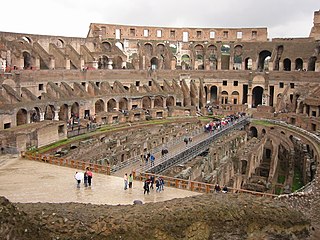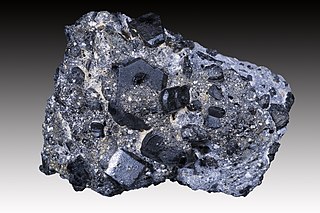
Ajax was a Greek mythological hero, son of Oileus, the king of Locris. He was called the "lesser" or "Locrian" Ajax, to distinguish him from Ajax the Great, son of Telamon. He was the leader of the Locrian contingent during the Trojan War. He is a significant figure in Homer's Iliad and is also mentioned in the Odyssey, in Virgil's Aeneid and in Euripides' The Trojan Women. In Etruscan legend, he was known as Aivas Vilates.
In geology, felsic refers to igneous rocks that are relatively rich in elements that form feldspar and quartz. It is contrasted with mafic rocks, which are relatively richer in magnesium and iron. Felsic refers to silicate minerals, magma, and rocks which are enriched in the lighter elements such as silicon, oxygen, aluminium, sodium, and potassium. Felsic magma or lava is higher in viscosity than mafic magma/lava.

Marble is a metamorphic rock composed of recrystallized carbonate minerals, most commonly calcite or dolomite. Marble is typically not foliated, although there are exceptions. In geology, the term "marble" refers to metamorphosed limestone, but its use in stonemasonry more broadly encompasses unmetamorphosed limestone. Marble is commonly used for sculpture and as a building material.

Plagioclase is a series of tectosilicate (framework silicate) minerals within the feldspar group. Rather than referring to a particular mineral with a specific chemical composition, plagioclase is a continuous solid solution series, more properly known as the plagioclase feldspar series (from the Ancient Greek for "oblique fracture", in reference to its two cleavage angles). This was first shown by the German mineralogist Johann Friedrich Christian Hessel (1796–1872) in 1826. The series ranges from albite to anorthite endmembers (with respective compositions NaAlSi3O8 to CaAl2Si2O8), where sodium and calcium atoms can substitute for each other in the mineral's crystal lattice structure. Plagioclase in hand samples is often identified by its polysynthetic crystal twinning or 'record-groove' effect.

An amphitheatre or amphitheater is an open-air venue used for entertainment, performances, and sports. The term derives from the ancient Greek ἀμφιθέατρον (amphitheatron), from ἀμφί (amphi), meaning "on both sides" or "around" and θέατρον (théātron), meaning "place for viewing".

Mount Sinai, also known as Mount Horeb or Gabal Musa, is a mountain in the Sinai Peninsula of Egypt that is a possible location of the biblical Mount Sinai, which is considered a holy site by the Abrahamic religions. Mount Sinai is mentioned many times in the Book of Exodus and other books of the Bible, and the Quran. According to Jewish, Christian, and Islamic tradition, the biblical Mount Sinai was the place where Moses received the Ten Commandments.

In Greek mythology, Pyrrha was the daughter of Epimetheus and Pandora and wife of Deucalion of whom she had three sons, Hellen, Amphictyon, Orestheus; and three daughters Protogeneia, Pandora II and Thyia. According to some accounts, Hellen was credited to be born from Pyrrha's union with Zeus.

Petrology is the branch of geology that studies rocks and the conditions under which they form. Petrology has three subdivisions: igneous, metamorphic, and sedimentary petrology. Igneous and metamorphic petrology are commonly taught together because they both contain heavy use of chemistry, chemical methods, and phase diagrams. Sedimentary petrology is, on the other hand, commonly taught together with stratigraphy because it deals with the processes that form sedimentary rock.

Augite is a common rock-forming pyroxene mineral with formula (Ca,Na)(Mg,Fe,Al,Ti)(Si,Al)2O6. The crystals are monoclinic and prismatic. Augite has two prominent cleavages, meeting at angles near 90 degrees.

Pyroclastic rocks or pyroclastics are sedimentary clastic rocks composed solely or primarily of volcanic materials. Where the volcanic material has been transported and reworked through mechanical action, such as by wind or water, these rocks are termed volcaniclastic. Commonly associated with unsieved volcanic activity—such as Plinian or krakatoan eruption styles, or phreatomagmatic eruptions—pyroclastic deposits are commonly formed from airborne ash, lapilli and bombs or blocks ejected from the volcano itself, mixed in with shattered country rock.

Geodes are geological secondary formation within sedimentary and volcanic rocks. Geodes are hollow, vaguely circular rocks, in which masses of mineral matter are secluded. The crystals are formed by the filling of vesicles in volcanic and sub-volcanic rocks by minerals deposited from hydrothermal fluids; or by the dissolution of syn-genetic concretions and partial filling by the same, or other minerals precipitated from water, groundwater or hydrothermal fluids.

Phyllite is a type of foliated metamorphic rock created from slate that is further metamorphosed so that very fine grained white mica achieves a preferred orientation. It is primarily composed of quartz, sericite mica, and chlorite.
A protolith is the original, unmetamorphosed rock from which a given metamorphic rock is formed.

Mount Smolikas is a mountain in the Ioannina regional unit, northwestern Greece. At a height of 2,637 metres above sea level, it is the highest of the Pindus Mountains, and the second highest mountain in Greece after Mount Olympus. The mountain consists of ophiolite rocks. During several periods in the Pleistocene the northern and eastern cirques and valleys were glaciated. The last glaciers of this area retreated around 11,500 years ago. It is drained by the river Aoos to the south, and the river Vourkopotamo to the north. There is a small alpine lake called "Drakolimni Smolika" near the summit, at about 2,200 metres elevation. Nearby mountain ranges are Tymfi to the south, Gramos to the northwest, Vasilitsa to the southeast and Voio to the northeast.

Piperi is a Greek island in the Northern Sporades. It is administratively part of the municipality of Alonnisos and, after Skyros, is the Sporades' easternmost island. As of 2011, the resident population of the island was 6.

Imia or Kardak is a pair of small uninhabited islets in the Aegean Sea, situated between the Greek island chain of the Dodecanese and the southwestern mainland coast of Turkey.

Peristerovrachoi, are uninhabited Greek islets/rocks, in the Aegean Sea, close to the eastern coast of Crete. Administratively they lie within the Itanos municipality of Lasithi.
Ftena Trachylia, also known as Pinnacle Rocks, are a group of uninhabited Greek islets/rocks, in the Aegean Sea, close to the eastern coast of Crete. Administratively they lie within the Itanos municipality of Lasithi.
Ammoudi tous Volakous is an uninhabited islet to the south of the western coast of Crete in the Libyan Sea. Just south of Sfakia it is within Sfakia's administration, in Chania regional unit.
The geology of Greece is highly structurally complex due to its position at the junction between the European and African tectonic plates.

















